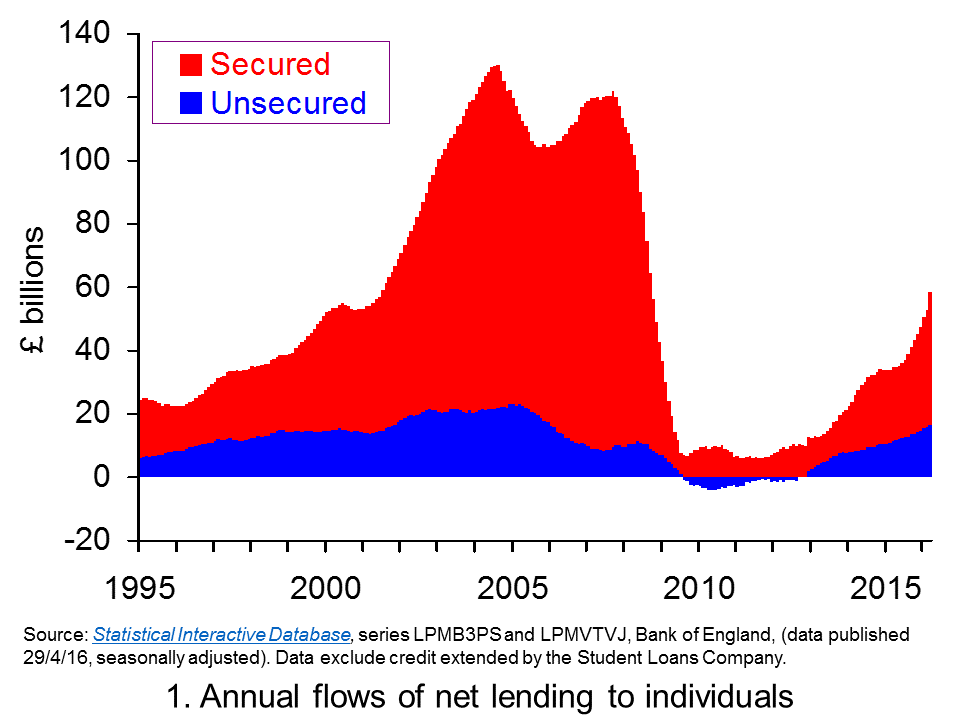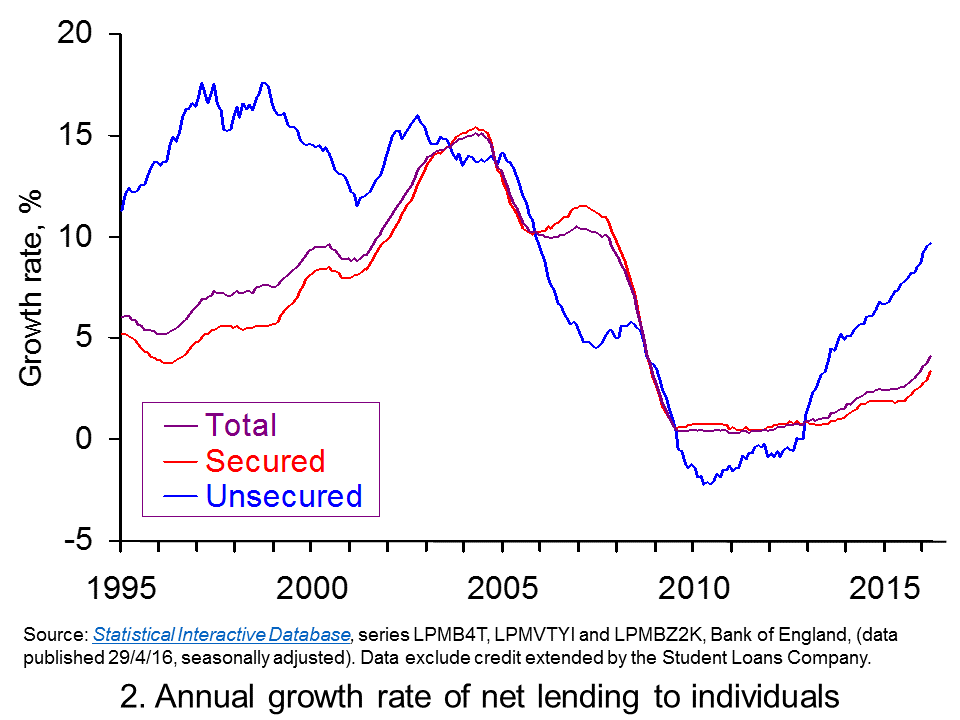 In April we asked how sustainable is the UK’s appetite for credit? Data in the latest Bank of England’s Money and Credit publication suggest that such concerns are likely grow. It shows net lending (lending net of repayments) by monetary financial institutions (MFIs) to individuals in March 2016 was £9.3 billion, the highest monthly total since August 2007. This took net borrowing over the previous 12 months to £58.6 billion, the highest 12-month figure since September 2008.
In April we asked how sustainable is the UK’s appetite for credit? Data in the latest Bank of England’s Money and Credit publication suggest that such concerns are likely grow. It shows net lending (lending net of repayments) by monetary financial institutions (MFIs) to individuals in March 2016 was £9.3 billion, the highest monthly total since August 2007. This took net borrowing over the previous 12 months to £58.6 billion, the highest 12-month figure since September 2008.
The latest credit data raise fears about the impact on the financial well-being of individuals. The financial well-being of people, companies, banks and governments can have dramatic effects on economic activity. These were demonstrated vividly in the late 2000s when a downturn resulted from attempts by economic agents to improve their financial well-being. Retrenchment led to recession. Given the understandable concerns about financial distress we revisit our April blog.
 Chart 1 shows the annual flow of lending extended to individuals, net of repayments. (Click here to download a PowerPoint of Chart 1.) The chart provides evidence of cycles both in secured lending and in consumer credit (unsecured lending).
Chart 1 shows the annual flow of lending extended to individuals, net of repayments. (Click here to download a PowerPoint of Chart 1.) The chart provides evidence of cycles both in secured lending and in consumer credit (unsecured lending).
The growth in net lending during the 2000s was stark as was the subsequent squeeze on lending that followed. During 2004, for example, annual net flows of lending from MFIs to individuals exceeded £130 billion, the equivalent of close on 10.5 per cent of annual GDP. Secured lending was buoyed by strong house price growth with UK house price inflation rising above 14 per cent. Nonetheless, consumer credit was very strong too equivalent to 1.8 per cent of GDP.
Net lending collapsed following the financial crisis. In the 12 months to March 2011 the flow of net lending amounted to just £3.56 billion, a mere 0.2 per cent of annual GDP. Furthermore, net consumer credit was now negative. In other words, repayments were exceeding new sums being extended by MFIs.

Clearly, as Chart 1 shows, net lending to individuals is again on the rise. This partly reflects a rebound in sections of the UK housing market. Net secured lending in March was £7.435 billion, the highest monthly figure since November 2007. Over the past 12 months net secured lending has amounted to £42.1 billion, the highest 12-month figure since October 2008.
Yet the growth of unsecured credit has been even more spectacular. In March net consumer credit was £1.88 billion (excluding debt extended by the Student Loans Company). This is the highest month figure since March 2005. It has taken the amount of net consumer credit extended to individuals over the past 12 months to £16.435 billion, the highest figure since December 2005.
 Chart 2 shows the annual growth rate of both forms of net lending by MFIs. In essence, this mirrors the growth rate in the stocks of debt – though changes in debt stocks can also be affected by the writing off of debts. The chart captures the very strong rates of growth in net unsecured lending from MFIs. We are now witnessing the strongest annual rate of growth in consumer credit since November 2005. (Click here to download a PowerPoint of the chart.)
Chart 2 shows the annual growth rate of both forms of net lending by MFIs. In essence, this mirrors the growth rate in the stocks of debt – though changes in debt stocks can also be affected by the writing off of debts. The chart captures the very strong rates of growth in net unsecured lending from MFIs. We are now witnessing the strongest annual rate of growth in consumer credit since November 2005. (Click here to download a PowerPoint of the chart.)
The growth in household borrowing, especially that in consumer credit, evidences the need for individuals to be mindful of their financial well-being. Given that these patterns are now becoming well-established you can expect to see considerable comment in the months ahead about our appetite for credit. Can such an appetite for borrowing be sustained without triggering a further balance sheet recession as experienced at the end of the 2000s?
Articles
Consumer credit rises at fastest pace for 11 years The Guardian, Hilary Osborne (29/4/16)
Debt bubble fears increase as consumer credit soars to 11-year high The Telegraph, Szu Ping Chan (29/4/16)
Fears of households over-stretching on borrowing as consumer credit grows The Scotsman, (29/4/16)
History repeating? Fears of another financial crisis as borrowing reaches 11-year high Sunday Express, Lana Clements (29/4/16)
The chart that shows we put more on our credit cards in March than in any month in 11 years Independent, Ben Chu (1/4/16)
Britain’s free market economy isn’t working The Guardian (13/1/16)
Data
Money and Credit – March 2016 Bank of England
Bankstats (Monetary and Financial Statistics) – Latest Tables Bank of England
Statistical Interactive Database Bank of England
Questions
- What does it mean if individuals are financially distressed?
- How would we measure the financial well-being of individuals and households?
- What actions might individuals take it they are financially distressed? What might the economic consequences be?
- How might uncertainty affect spending and saving by households?
- What measures can policymakers take to reduce the likelihood that flows of credit become too excessive?
- What is meant by a balance sheet recession?
- Explain the difference between secured debt and unsecured debt.
- Should we be more concerned about the growth of consumer credit than secured debt?
 In the blog post, Global warning, we looked at the use of unconventional macroeconomic policies to deal with the slow pace of economic growth around the world. One of the articles was by Nouriel Roubini. In the linked article below, he argues that slow economic growth may be the new global norm.
In the blog post, Global warning, we looked at the use of unconventional macroeconomic policies to deal with the slow pace of economic growth around the world. One of the articles was by Nouriel Roubini. In the linked article below, he argues that slow economic growth may be the new global norm.
At the centre of the problem is a fall in the rate of potential economic growth. This has been caused by a lack of investment, which has slowed the pace of innovation and the growth in labour productivity.
The lack of investment, in turn, has been caused by a lack of spending by both households and governments. What is the point in investing in new capacity, argue firms, if they already have spare capacity?
Low consumer spending is partly the result of a redistribution of income from low- and middle-income households (who have a high marginal propensity to consume) to high-income households and corporations (who have a low mpc). Low spending is also the result of both consumers and governments attempting to reduce their levels of debt by cutting back spending.
Low growth leads to hysteresis – the process whereby low actual growth leads to low potential growth. The reason is that the unemployed become deskilled and the lack of investment by firms reduces the innovation that is necessary to embed new technologies.
Read Roubini’s analysis and consider the policy implications.
Article
Has the global economic growth malaise become the ‘new normal’? The Guardian, Nouriel Roubini (2/5/16)
Questions
- Explain what is meant by ‘hysteresis’ and how the concept is relevant in explaining low global economic growth.
- Why has there been a reduction in the marginal propensity to consume in recent years? What is the implication of this for the multiplier and economic recovery?
- Explain what Roubini means by ‘a painful de-leveraging process’. What are the implications of this process?
- How important are structural reforms and what forms could these take? Why has there been a reluctance for governments to institute such reforms?
- ‘Asymmetric adjustment between debtor and creditor economies has also undermined growth.’ Explain what Roubini means by this.
- Why are governments reluctant to use fiscal policy to boost both actual and potential economic growth?
- What feasible policy measures could be taken to boost actual and potential economic growth?
 According to the BBC’s Joe Lynam, “Britain has the most competitive and dynamic retail environment in the world, which attracts shoppers globally.” It is perhaps this fact which may save BHS, with new owners being attracted by such an opportunity. BHS is soon expected to file for administration, with debts of more than £1.3 billion and having failed to secure the loan needed to keep it afloat. If this company collapses, it will bring an end to the life of an 88 year old giant.
According to the BBC’s Joe Lynam, “Britain has the most competitive and dynamic retail environment in the world, which attracts shoppers globally.” It is perhaps this fact which may save BHS, with new owners being attracted by such an opportunity. BHS is soon expected to file for administration, with debts of more than £1.3 billion and having failed to secure the loan needed to keep it afloat. If this company collapses, it will bring an end to the life of an 88 year old giant.
The British retail scene has certainly changed over the past decade, with names such as Woolworths and Comet disappearing – could BHS be the next casualty of the changing retail climate? In the world of retail, tastes change quickly and those stores who fail to change with the times are the ones that suffer. One of the factors behind the downfall of BHS is the ‘dated’ nature of its stores and fashions. As clothing outlets such as Zara, Oasis and Next have continued to change with the times, commentators suggest that BHS continues with a trading offer from the 1980s. With the online shopping trend, many household names adapted their strategy, but BHS failed to do so and the second chance that BHS asked the public for when Sir Philip Green, its former owner, sold BHS in 2015 hasn’t materialised.
With administrators ready to be brought in and thousands of jobs hanging in the balance, the administrators will be looking at methods to attract funding, new owners or so-called ‘cherry pickers’ who may be interested in buying up the more profitable stores. Some of their stores remain in prime locations and deliver a tidy profit and it is perhaps these gems, together with the tradition that British Home Stores brings that may yet see the company saved. The outcome for BHS will not only affect the jobs of its employees, but will affect the pensions of thousands of workers. The BHS pension fund currently has a deficit of £576 million and so the Pension Protection Fund will have to look closely at the situation before thinking about issues a contribution notice to those connected with the fund.
A deal was on the cards last week, with BHS owner Dominic Chappell in talks with Mike Ashley’s Sports Direct, but the high debts and pensions deficit appears to have deterred this deal. The failing fortunes of BHS have now come back to haunt former owner, Sir Philip Green, who in March 2015, sold the business for just £1. Sir Philip may return to save the day, but the options for this once giant of the British high street are rather limited. The following articles consider the fortunes of BHS.
BHS seeks Sports Direct lifeline as it heads for collapse The Guardian, Graham Ruddick (24/04/16)
BHS expected to file for administration on Monday BBC News (25/04/16)
Thousands of BHS workers face anxious wait amid administration fears The Telegraph (25/04/16)
BHS administration: ‘Imminent bankruptcy’ puts 11,000 jobs at risk Independent, Peter Yeung (25/04/16)
Up to 11,000 jobs face the axe as BHS is expected to announce collapse of chain after efforts to find rescuer failed Mail Online, Neil Craven (24/04/16)
BHS nears collapse putting 11,000 jobs at risk Sky News (25/04/16)
BHS set to file for administration after sales talks fail Financial Times, Murad Ahmed (25/04/16)
Questions
- Using a demand and supply diagram, can you explain some of the factors that have contributed to the difficult position that BHS finds itself in?
- Now, can you use a diagram showing revenues and profits and explain the current position of BHS?
- What type of market structure does BHS operate in? Can this be used to explain why it is in its current position?
- How has the company failed in adapting its business strategy to the changing times?
- Looking back at the history of BHS, can you apply the product life cycle to this store?
- If another company is considering purchasing BHS, or at least some of its stores, what key information will it need and what might make it likely to go ahead with such a purchase?
 The Treasury has published a paper analysing the costs of Britain leaving the EU. Its central assumption is that the UK would negotiate a bilateral trade deal with the EU similar to that between Canada and the EU. Under this assumption the Treasury estimates that, by 2030, GDP would be 6.2% lower than if the UK had remained in the EU, meaning that the average household would be £4300 per year worse off than it would otherwise have been. The analysis also finds that there would be a total reduction in tax receipts of £36 billion per year – far greater than any savings from lower contributions to the EU budget.
The Treasury has published a paper analysing the costs of Britain leaving the EU. Its central assumption is that the UK would negotiate a bilateral trade deal with the EU similar to that between Canada and the EU. Under this assumption the Treasury estimates that, by 2030, GDP would be 6.2% lower than if the UK had remained in the EU, meaning that the average household would be £4300 per year worse off than it would otherwise have been. The analysis also finds that there would be a total reduction in tax receipts of £36 billion per year – far greater than any savings from lower contributions to the EU budget.
Not surprisingly the ‘Vote Remain’ campaign for the UK to stay in the EU has welcomed the analysis, seeing it as strong evidence in support of their case. Also, not surprisingly, the Vote Leave campaign has questioned both the analysis and the assumptions on which it is based.
 The Treasury analysis looks at three possible scenarios: (a) a Canada-style bilateral arrangement (the central estimate); (b) the UK becoming a member or the European Economic Area – the ‘Norwegian model’ (according to the Treasury, this would reduce GDP by 3.8%); (c) no specific deal with the EU, with the UK simply having the same access to the EU as any other country that is a mamber of the WTO (this would reduce GDP by 7.5%). Thus the Norwegian model would probably result in a smaller reduction in growth, but the UK would still continue to make contributions to the EU budget and have to allow free movement of labour. Only in option (c) would it have total control over migration. Each of the estimates has a margin of error, giving a range for the reduction in GDP across the three scenarios from 3.4% to 9.5%.
The Treasury analysis looks at three possible scenarios: (a) a Canada-style bilateral arrangement (the central estimate); (b) the UK becoming a member or the European Economic Area – the ‘Norwegian model’ (according to the Treasury, this would reduce GDP by 3.8%); (c) no specific deal with the EU, with the UK simply having the same access to the EU as any other country that is a mamber of the WTO (this would reduce GDP by 7.5%). Thus the Norwegian model would probably result in a smaller reduction in growth, but the UK would still continue to make contributions to the EU budget and have to allow free movement of labour. Only in option (c) would it have total control over migration. Each of the estimates has a margin of error, giving a range for the reduction in GDP across the three scenarios from 3.4% to 9.5%.
The Treasury used a three-stage process to arrive at its conclusions, as explained in the FT article below:
First, it uses gravity models to estimate the effect of different trade relationships on the quantity of trade and foreign direct investment. Gravity models take into account how close countries are to each other geographically, as well as their historical links, rather than assuming that trade flows to wherever the lowest tariffs are.
Second, it uses external academic results to estimate the consequences for productivity – the efficiency of the UK economy – from different levels of trade and foreign direct investment.
Third, it plugs the productivity numbers unto a global economic model run by the National Institute of Economic and Social Research to estimate the long-run differences in national income and prosperity.
Clearly there is large-scale uncertainty over any forecasts 14 years ahead, especially when the relationship with the EU and other countries post-EU exit can only be roughly estimated. The question is whether the assumptions are reasonable and whether there would be substantial costs from Brexit, but not necessarily of £4300 per household.
The following articles look at the analysis and its assumptions. Unlike many newspaper articles, which clearly have an agenda, these articles are relatively unbiased and try to assess the arguments. Of course, it would be difficult to be totally unbiased and it would be a good idea to try to spot any biases in each of the articles.
Articles
Treasury’s Brexit analysis: what it says — and what it doesn’t Financial Times, Chris Giles (18/4/16)
A Treasury analysis suggests the costs of Brexit would be high The Economist (18/4/16)
George Osborne says UK would lose £36bn in tax receipts if it left EU The Guardian, Anushka Asthana and Tom Clark (18/4/16)
Will each UK household be £4,300 worse off if the UK leaves the EU? The Guardian, Larry Elliott (18/4/16)
FactCheck Q&A: can we trust the Treasury on Brexit? Channel 4 News, Patrick Worrall (18/4/16)
Reality Check: Would Brexit cost your family £4,300? BBC News, Anthony Reuben (18/4/16)
Brexit sparks outbreak of agreement among economists Financial Times, Chris Giles (27/4/16)
Treasury analysis
EU referendum: HM Treasury analysis key facts HM Treasury (18/4/16)
HM Treasury analysis: the long-term economic impact of EU membership and the alternatives HM Treasury (18/4/16)
Questions
- Would households actually be poorer if the Treasury’s forecasts are correct?
- What alternative trade arrangements with the EU would be possible if the UK left the EU?
- What are the Treasury model’s main weaknesses?
- What considerations are UK voters likely to take into account in the referendum which are not included in the Treasury analysis?
- Make out the case for supporting the analysis of the Treasury.
- Make out the case for rejecting the analysis of the Treasury.
 In a recent post, Global Warning, we looked at concerns about the global economy. One of these was about the ineffectiveness of monetary policy to stimulate aggregate demand and to restore growth rates. Despite the use of unconventional monetary policies, such as quantitative easing and negative interest rates, and despite the fact that these policies have become the new convention, they have failed to do enough to bring sustained recovery.
In a recent post, Global Warning, we looked at concerns about the global economy. One of these was about the ineffectiveness of monetary policy to stimulate aggregate demand and to restore growth rates. Despite the use of unconventional monetary policies, such as quantitative easing and negative interest rates, and despite the fact that these policies have become the new convention, they have failed to do enough to bring sustained recovery.
The two articles below argue that the failure has been due to a flawed model of monetary policy: one that takes too little account of the behaviour of banks and the drivers of consumption and of physical investment. Negative interest rates on banks’ holdings of reserves in central banks are hardly likely to push down lending rates to businesses sufficiently to stimulate investment in new plant and machinery if firms already have overcapacity. And consumers are unlikely to borrow more for consumption if their wages are barely rising and they already have debts that they fear will be difficulty to pay off.
As Joseph Stiglitz points out:
As real interest rates have fallen, business investment has stagnated. According to the OECD, the percentage of GDP invested in a category that is mostly plant and equipment has fallen in both Europe and the US in recent years. (In the US, it fell from 8.4% in 2000 to 6.8% in 2014; in the EU, it fell from 7.5% to 5.7% over the same period.) Other data provide a similar picture.
And the unwillingness of many firms and individuals to borrow is matched by banks’ caution about lending in an uncertain economic environment. Many are more concerned about building their capital and liquidity ratios to protect themselves. In these circumstances, negative interest rates have little effect on stimulating bank lending and, by hurting their balance sheets through lower earnings on the money markets, may even encourage them to lend less
In these circumstances, negative interest rates have little effect on stimulating bank lending and, by hurting their balance sheets through lower earnings on the money markets, may even encourage them to lend less
What central banks should be doing, argue both Stiglitz and Elliott, is finding ways of directly stimulating consumption and investment. Perhaps this will involve central banks “focusing on the flow of credit, which means restoring and maintaining local banks’ ability and willingness to lend to SMEs.” Perhaps it will mean using helicopter money, as we examined in the previous blog. As Larry Elliott points out:
The fact that economists at Deutsche Bank published a helpful cut-out-and-keep guide to helicopter  money last week is a straw in the wind.
money last week is a straw in the wind.
As the Deutsche research makes clear, the most basic variant of helicopter money involves a central bank creating money so that it can be handed to the finance ministry to spend on tax cuts or higher public spending. There are two differences with QE. The cash goes directly to firms and individuals rather than being channelled through banks, and there is no intention of the central bank ever getting it back.
So if the model of monetary policy is indeed flawed, prepare for more unconventional measures
Articles
What’s Wrong With Negative Rates?, Project Syndicate, Joseph Stiglitz (13/4/16)
The bad smell hovering over the global economy The Guardian, Larry Elliott (17/4/16)
Questions
- What arguments does Stiglitz use to support his claim that the model of monetary policy currently being used is flawed?
- In what ways has monetary policy hurt older people and what has been the effect on their spending and on aggregate demand in general?
- Why has monetary policy encouraged investors to shift their portfolios toward riskier assets?
- Examine the argument that ultra-low interest rates may result in a rise in unemployment in the long term by affecting the relative prices of capital and labour.
- What forms might helicopter money take?
- Would the use of helicopter money necessarily result in an increase in aggregate demand? What would determine the size of any such increase?
 In April we asked how sustainable is the UK’s appetite for credit? Data in the latest Bank of England’s Money and Credit publication suggest that such concerns are likely grow. It shows net lending (lending net of repayments) by monetary financial institutions (MFIs) to individuals in March 2016 was £9.3 billion, the highest monthly total since August 2007. This took net borrowing over the previous 12 months to £58.6 billion, the highest 12-month figure since September 2008.
In April we asked how sustainable is the UK’s appetite for credit? Data in the latest Bank of England’s Money and Credit publication suggest that such concerns are likely grow. It shows net lending (lending net of repayments) by monetary financial institutions (MFIs) to individuals in March 2016 was £9.3 billion, the highest monthly total since August 2007. This took net borrowing over the previous 12 months to £58.6 billion, the highest 12-month figure since September 2008. Chart 1 shows the annual flow of lending extended to individuals, net of repayments. (Click here to download a PowerPoint of Chart 1.) The chart provides evidence of cycles both in secured lending and in consumer credit (unsecured lending).
Chart 1 shows the annual flow of lending extended to individuals, net of repayments. (Click here to download a PowerPoint of Chart 1.) The chart provides evidence of cycles both in secured lending and in consumer credit (unsecured lending).
 Chart 2 shows the annual growth rate of both forms of net lending by MFIs. In essence, this mirrors the growth rate in the stocks of debt – though changes in debt stocks can also be affected by the writing off of debts. The chart captures the very strong rates of growth in net unsecured lending from MFIs. We are now witnessing the strongest annual rate of growth in consumer credit since November 2005. (Click here to download a PowerPoint of the chart.)
Chart 2 shows the annual growth rate of both forms of net lending by MFIs. In essence, this mirrors the growth rate in the stocks of debt – though changes in debt stocks can also be affected by the writing off of debts. The chart captures the very strong rates of growth in net unsecured lending from MFIs. We are now witnessing the strongest annual rate of growth in consumer credit since November 2005. (Click here to download a PowerPoint of the chart.)









